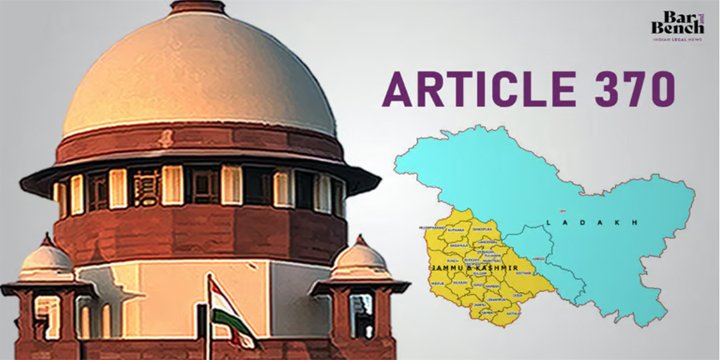Supreme Court to deliver verdict on Article 370 on Monday: The challenge and issues
Context- The Supreme Court will pronounce its verdict on December 11 on a batch of petitions, which challenged the abrogation of Article 370 of the Constitution in 2019. In August and September this year, the SC heard the petitioners and the government over the provision on the erstwhile state of Jammu and Kashmir.
(Credits- NDTV)
A five-judge constitution bench headed by Chief Justice DY Chandrachud will deliver the verdict. Other bench members are Justices Sanjay Kishan Kaul, Sanjiv Khanna, B R Gavai and Surya Kant.
Why is the abrogation of Article 370 being challenged in SC?
- On August 5, 2019, the Central government decided to revoke Article 370 of the Indian Constitution. President Ram Nath Kovind issued Constitutional Order 272, which made certain changes to Article 367, affecting how Article 370 would be read. This allowed for changes to be made to Article 370.
- Within a few hours, Rajya Sabha recommended that the Article should cease to operate. The next day, the President issued Constitutional Order 273 to formalise this recommendation, confirming the abrogation of Article 370.
- On August 9, Parliament passed the Jammu and Kashmir Reorganisation Act, which bifurcated the state into two Union Territories – Jammu and Kashmir and Ladakh.
- Petitioners have challenged the validity of CO 272 and CO 273, and the President’s power to make the provision inoperable.
- During the hearings, the top court also asked how Article 370, which was mentioned as a temporary provision in the Constitution, became permanent after the tenure of the Jammu and Kashmir constituent assembly came to an end in 1957.
- Some of the petitioners argued that the provision could not have been abrogated, as the term of the Jammu and Kashmir Constituent Assembly ended in 1957 after it drafted the erstwhile state’s Constitution. Its concurrence was required before taking such a step.
- The SC asked who could recommend the revocation of Article 370 in Jammu and Kashmir when no constituent assembly exists there.
- The Centre argued that there was no “constitutional fraud” in annulling the provision.
What was Article 370?
- Article 370 accorded a special status to the erstwhile state of Jammu and Kashmir within the Indian Union.
- Included in the Constitution on October 17, 1949, Article 370 exempts J&K from the Indian Constitution (except Article 1 and Article 370 itself) and permits the state to draft its own Constitution. It restricts Parliament’s legislative powers in respect of J&K.
- For extending a central law on subjects included in the Instrument of Accession (IoA), mere “consultation” with the state government is needed. But for extending it to other matters, “concurrence” of the state government is mandatory. The IoA came into play when the Indian Independence Act, 1947 divided British India into India and Pakistan.
- It followed attempts to bring independent provinces under the Indian Union after British colonial rule over the subcontinent ended in 1947. Some other states (such as Mizoram, Nagaland, Maharashtra, Gujarat, etc.) also enjoy special status under Article 371, from 371A to 371I.
- In a letter to J&K Prime Minister Sheikh Abdullah dated May 17, 1949, Indian Prime Minister Jawaharlal Nehru, with the concurrence of Home Minister Vallabhbhai Patel and N Gopalaswami Ayyangar (J&K Prime Minister from 1936-43), wrote:
- “It has been settled policy of Government of India, which on many occasions has been stated both by Sardar Patel and me, that the Constitution of Jammu and Kashmir is a matter for determination by the people of the state represented in a Constituent Assembly convened for the purpose.”
Why was Article 370 revoked?
- Revocation of Article 370 has found a place in the BJP manifesto at times over the years. It has also been one of the central issues for the RSS, the ideological parent of the BJP.
- As early as 1953, J&K Praja Parishad, an organisation formed by the late Bharatiya Jana Sangh leader Balraj Madhok, started a movement for “complete integration”.
- Syama Prasad Mookerjee, the founder president of the Bharatiya Jana Sangh (which the BJP would later emerge from), agitated with the slogan: “Ek desh me do vidhan, do pradhan, do nishan, nahi chalega, nahi chalega (One country cannot have two constitutions, two Prime Ministers, and two flags)”.
- Speaking in Parliament in 2019, Home Minister Amit Shah said Article 370 was “harmful for the unity of the nation”. He also said that Article 370 had confined the Kashmiri culture to a geographical corner of the country and with its removal, the culture of the state would spread to other parts of the nation.
- Shah also criticised Nehru’s decision to take the cause of Kashmir, over which Pakistan also laid claims, to the United Nations.
Conclusion- The Home Minister recently said in parliament that Article 370 was “the root cause” of separatism and terrorism in J&K. However, The Supreme Court’s Judgment is expected to shed more light on the legality of the move, in particular the process of abrogation.
Syllabus- GS-2; Constitution
Source- Indian Express



